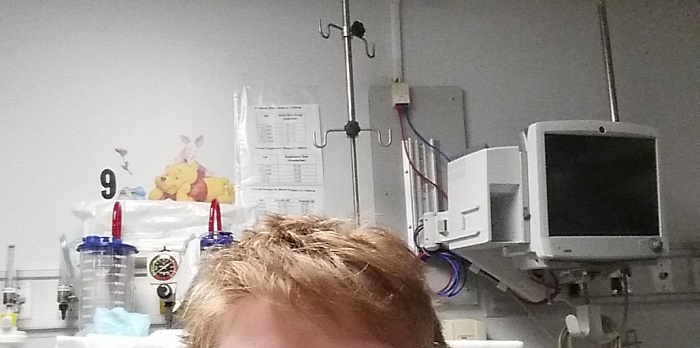If you’ve been following along with my patient journey, you might recall that I’ve had a number of nerve blocks since my diagnosis 3 years ago:
- Stellate ganglion blocks
- Axillary brachial plexus blocks
Some chronic pain specialists and researchers feel that these nerve blocks are helpful in managing – and sometimes diagnosing – specific pain conditions. Others believe that these blocks do no good, while a few simply state that their risk of harm always outweighs any potential benefit to the patient.
This is disconcerting, because chronic pain is so badly understood – even among medical professionals – that disagreement between them creates additional uncertainties for patients.
The complexity of some pain conditions requires multidisciplinary coordination among health care professionals; in addition to the direct consequences of acute and chronic pain, the experience of pain can exacerbate other health issues, including delayed recovery from surgery or worsen behavioral and mental health disorders.
Achieving excellence in patient-centered care depends on a strong patient-clinician relationship defined by mutual trust and respect, empathy, and compassion, resulting in a strong therapeutic alliance.”(1)
So I was pleased to see, from both my bioethics and rare disease patient perspectives, that sympathetic nerve blocks were specifically mentioned as a treatment for Complex Regional Pain Syndrome (CRPS) in a US Government task force report. This report was released earlier this month:
Pain Management Best Practices Inter-Agency Task Force Report: Updates, Gaps, Inconsistencies, and Recommendations” (1)
Although this Task Force Report makes a number of recommendations, there were two in particular which resonated with me. Again, in my dual roles as biomedical ethics professional and chronic pain patient advocate; not only for myself, but for other patients with chronic pain conditions and rare diseases.
Although I owe my current quality of life (QOL) – such as it is – largely to the pain specialists at a university hospital, most patients first present with chronic pain to their family physicians. Family doctors are also called primary care providers.
Unfortunately, most family physicians lack adequate training in pain management. This is through no fault of their own, but rather a result of the priorities of medical schools and medical education.
This should surprise you, given that a 2011 research study on chronic pain in Canada found that:
The prevalence of chronic pain prevalence for adults older than 18 years of age was 18.9%. This was comparable with the overall mean reported using identical survey questions and criteria for chronic pain used in the European study.
Chronic pain prevalence was greater in older adults, and females had a higher prevalence at older ages compared with males.
Approximately one-half of those with chronic pain reported suffering for more than 10 years. Approximately one-third of those reporting chronic pain rated the intensity in the very severe range.”(2)
Recommendation 1B of the Task Force Report is meant to address this gap, to better prepare family physicians to care for individuals suffering with chronic pain conditions:
Primary care and non-pain specialists should have timely, early consultation with pain specialists and other members of the pain management team for the assessment of patients with complex pain to prevent complications and loss of function and to improve QOL, as clinically indicated.”(1)
What was the second point, in the recent US Task Force Report which struck me as being so important? The discussion of sympathetic nerve blocks (SNPs) and peripheral nerve blocks (PNPs), including for my own disease; CRPS:
Sympathetic nerve blocks (SNBs), similar to PNBs, are injections of local anesthesia at the sympathetic nerve chain that can be used to diagnose or treat pain that involves the sympathetic nervous system.
SNBs have been used to treat neuropathic pain, Complex Regional Pain Syndrome… as well as manage chronic abdominal, pelvic, and perineal pain.”(1)

It was reassuring to see these nerve blocks, which I’ve had on numerous occasions – all in hospital! – definitively shown as acceptable treatments for CRPS. Although there are risks involved with these invasive treatments, these risks can be minimized by allowing them to be done only in a hospital setting – with full access to any required emergency or follow-up care.
As always, when discussing medical information – please bear in mind that I’m not a doctor; I’m writing as a patient who has experience in clinical or medical research and who has worked in hospitals and healthcare for most of my life.
References:
(1) U.S. Department of Health and Human Services (HHS). Pain Management Best Practices Inter-Agency Task Force Report: Updates, Gaps, Inconsistencies, and Recommendations. 09 May 2019. Online. Accessed 31 May 2019. Web:
https://www.hhs.gov/ash/advisory-committees/pain/reports/index.html
(2) Schopflocher D, Taenzer P, Jovey R. The prevalence of chronic pain in Canada. Pain Res Manag. 2011;16(6):445–450. Online. [doi:10.1155/2011/876306]. Accessed 31 May 2019. Web:
https://www.ncbi.nlm.nih.gov/pmc/articles/PMC3298051/
